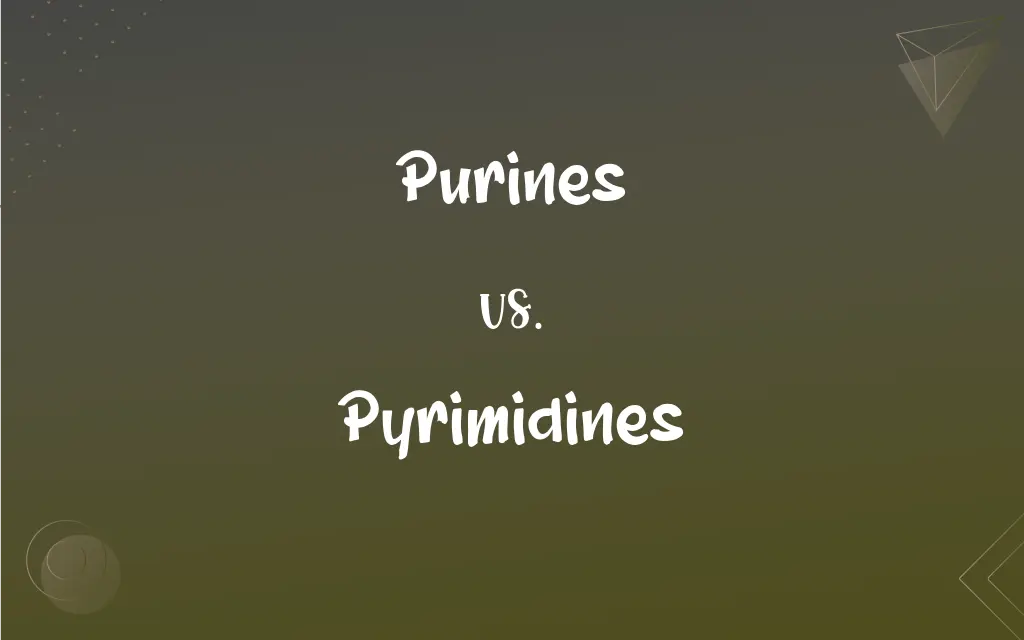Purines vs. Pyrimidines: What's the Difference?
Edited by Janet White || By Harlon Moss || Updated on October 12, 2023
Purines and pyrimidines are nitrogenous bases in DNA and RNA; purines have a two-ring structure (adenine, guanine) while pyrimidines have a one-ring structure (cytosine, thymine in DNA; uracil in RNA).

Key Differences
Purines are distinguished by their two-ring nitrogenous base, an essential element in the DNA and RNA molecules. They consist of adenine and guanine, pivotal in the formation of DNA and RNA strands by establishing a robust network through hydrogen bonding. Pyrimidines, on the other hand, manifest a single-ring nitrogenous base, featuring in DNA and RNA as cytosine and thymine (or uracil in RNA). The engagement of purines and pyrimidines is fundamental in the assembly of nucleic acids, ensuring the stability and integrity of genetic information.
The comparison between purines and pyrimidines isn't simply a matter of structural difference, but also of their roles within the genetic sequence. Purines, with their larger, dual-ring structure, interlink with pyrimidines to stabilize the DNA helix, with adenine pairing to thymine (or uracil in RNA) and guanine pairing to cytosine. Pyrimidines facilitate the maintenance of DNA’s double helix structure due to their smaller size, as larger purines would generate steric hindrance and disrupt the helical structure.
When it comes to mutations, purines and pyrimidines also exhibit notable distinctions. Transitions are mutations where a purine is replaced by another purine, or a pyrimidine is replaced by a different pyrimidine. Pyrimidines, due to their singular structure, may have different transitional mutations compared to purines. Meanwhile, transversions, which involve a purine being replaced by a pyrimidine or vice versa, showcase how purines and pyrimidines play a critical role in the accurate transmission of genetic information.
Molecularly, purines and pyrimidines are vital in numerous cellular processes including cell division and the synthesis of proteins. Purines engage in various biological activities, such as energy-transfer tasks via adenosine triphosphate (ATP) and guanosine triphosphate (GTP). Conversely, pyrimidines act as fundamental components in synthesizing DNA and RNA and ensuring their stability through proper base pairing, preserving the structural consistency of the genetic codes.
Lastly, in a broader context of cellular metabolism, purines and pyrimidines are synthesized and degraded through separate pathways, indicating their unique metabolic demands and roles. Purines, involved in a plethora of cellular functions beyond genetic information storage, have extensive metabolic pathways, whereas pyrimidines have pathways that meticulously oversee their synthesis and degradation, highlighting the regulatory balance that sustains cellular functionality and integrity.
ADVERTISEMENT
Comparison Chart
Structural Base
Two-ring structure
Single-ring structure
Examples
Adenine (A), Guanine (G)
Cytosine (C), Thymine (T), Uracil (U)
Pairing
Adenine pairs with Thymine (DNA) or Uracil (RNA)
Cytosine pairs with Guanine
Occurrence
Found in DNA and RNA
Found in DNA and RNA, with Uracil replacing Thymine in RNA
Biological Role
Involved in energy transfer (ATP, GTP)
Critical in stabilizing and synthesizing DNA/RNA
ADVERTISEMENT
Purines and Pyrimidines Definitions
Purines
Purines are double-ringed nitrogenous bases found in DNA and RNA.
Adenine and guanine are the two purines essential for forming base pairs in DNA.
Pyrimidines
Pyrimidines are single-ringed nitrogenous bases integral to DNA and RNA.
Cytosine and thymine are pyrimidines crucial for the structure of DNA strands.
Purines
Purines play a vital role in energy transfer within cells via molecules like ATP.
The purines in ATP are fundamental for storing and transferring energy in cells.
Pyrimidines
Pyrimidines include cytosine, thymine, and uracil, each participating in genetic coding.
Uracil, a pyrimidine, replaces thymine in RNA, facilitating protein synthesis.
Purines
In genetics, purines always pair with specific pyrimidines to maintain DNA stability.
In DNA, purines like adenine pair with thymine to uphold structural integrity.
Pyrimidines
Pyrimidines contribute to maintaining the helical structure of DNA through specific base pairing.
Thymine, a pyrimidine, pairs with adenine, assisting in maintaining DNA’s helical form.
Purines
Purines are implicated in numerous cellular functions, including protein synthesis and cell signaling.
Purines are pivotal in cellular communication, being integral components of signaling molecules.
Pyrimidines
In genetic mutations, pyrimidines may be substituted with other pyrimidines or purines.
Genetic variations can occur when pyrimidines like cytosine are replaced by other bases in DNA sequences.
Purines
Within genetic mutations, purines can be substituted for one another in transitions.
During transitions, swapping between the purines, adenine and guanine, can occur.
Pyrimidines
In DNA, pyrimidines form base pairs by connecting with specific purines.
Pyrimidines ensure DNA stability by forming precise base pairs with purines.
Purines
A double-ringed, crystalline organic base, C5H4N4, that is the parent compound of a large group of biologically important compounds.
Pyrimidines
A single-ringed, crystalline organic base, C4H4N2, that is the parent compound of a large group of biologically important compounds.
Purines
Any of a group of substituted derivatives of purine, including the nitrogen bases adenine and guanine, which are components of nucleic acids. Uric acid, caffeine, theobromine, and theophylline are also purines.
Pyrimidines
Any of a group of substituted derivatives of pyrimidine, including the nitrogen bases uracil, cytosine, and thymine, which are components of nucleic acids. Barbiturates and certain other drugs are also pyrimidines.
Purines
Plural of purine
Pyrimidines
Plural of pyrimidine
FAQs
How do purines pair in DNA?
In DNA, adenine (a purine) pairs with thymine, and guanine pairs with cytosine.
How do pyrimidines pair in RNA?
In RNA, uracil (a pyrimidine) pairs with adenine, and cytosine pairs with guanine.
What are purines?
Purines are double-ringed nitrogenous bases found in DNA and RNA, specifically adenine and guanine.
Why is the purine-pyrimidine pairing crucial?
The pairing maintains the stability and structure of the DNA double helix and ensures accurate genetic coding.
What are pyrimidines?
Pyrimidines are single-ringed nitrogenous bases found in DNA and RNA, including cytosine, thymine, and uracil.
How are purines and pyrimidines involved in mutations?
They can undergo substitutions (transitions or transversions) or deletions, altering genetic information and possibly leading to mutations.
How are purines and pyrimidines identified in laboratory settings?
Techniques like chromatography, spectroscopy, and sequencing are employed to identify and study purines and pyrimidines.
Are purines involved in energy transfer?
Yes, purines like adenine and guanine are components of ATP and GTP, respectively, playing vital roles in energy transfer.
What is the significance of purines and pyrimidines in genetics?
They encode genetic information, ensuring its accurate transmission during cellular processes like replication and transcription.
Can alterations in purine and pyrimidine metabolism impact health?
Yes, disorders in purine and pyrimidine metabolism can lead to health issues like gout or certain types of anemia.
Are purines and pyrimidines only found in DNA and RNA?
While crucial in DNA and RNA, purines and pyrimidines also appear in other molecules impacting cellular energy and signaling.
Can purines pair with purines in DNA?
Typically, no. Purines pair with pyrimidines to maintain the consistent structure of the DNA helix.
How are purines and pyrimidines degraded?
They are degraded through separate catabolic pathways, converting them into uric acid (purines) or β-amino acids (pyrimidines).
How does the structure of purines and pyrimidines influence DNA stability?
The complementary shapes and hydrogen bonding between purines and pyrimidines ensure the consistent distance between DNA strands, stabilizing the helix.
What roles do purines and pyrimidines play in RNA?
They maintain RNA’s structure and are integral in processes like protein synthesis, signaling, and gene regulation.
How are purines synthesized in the cell?
Purines are synthesized through a multifaceted pathway involving several enzymes, starting with ribose-5-phosphate.
How are pyrimidines synthesized?
Pyrimidines are synthesized from simpler molecules, involving a series of enzymatic actions, beginning with the formation of carbamoyl phosphate.
Why is thymine replaced by uracil in RNA?
Uracil is energetically less costly to produce and is utilized in RNA, which is typically short-lived compared to DNA.
Why are purines and pyrimidines essential for life?
They encode and transmit genetic information, participate in energy transfer, and are involved in various cellular processes crucial for life.
Do pyrimidines play a role in energy storage or transfer?
Generally, pyrimidines are not directly involved in cellular energy transfer like purines.
About Author
Written by
Harlon MossHarlon is a seasoned quality moderator and accomplished content writer for Difference Wiki. An alumnus of the prestigious University of California, he earned his degree in Computer Science. Leveraging his academic background, Harlon brings a meticulous and informed perspective to his work, ensuring content accuracy and excellence.
Edited by
Janet WhiteJanet White has been an esteemed writer and blogger for Difference Wiki. Holding a Master's degree in Science and Medical Journalism from the prestigious Boston University, she has consistently demonstrated her expertise and passion for her field. When she's not immersed in her work, Janet relishes her time exercising, delving into a good book, and cherishing moments with friends and family.































































